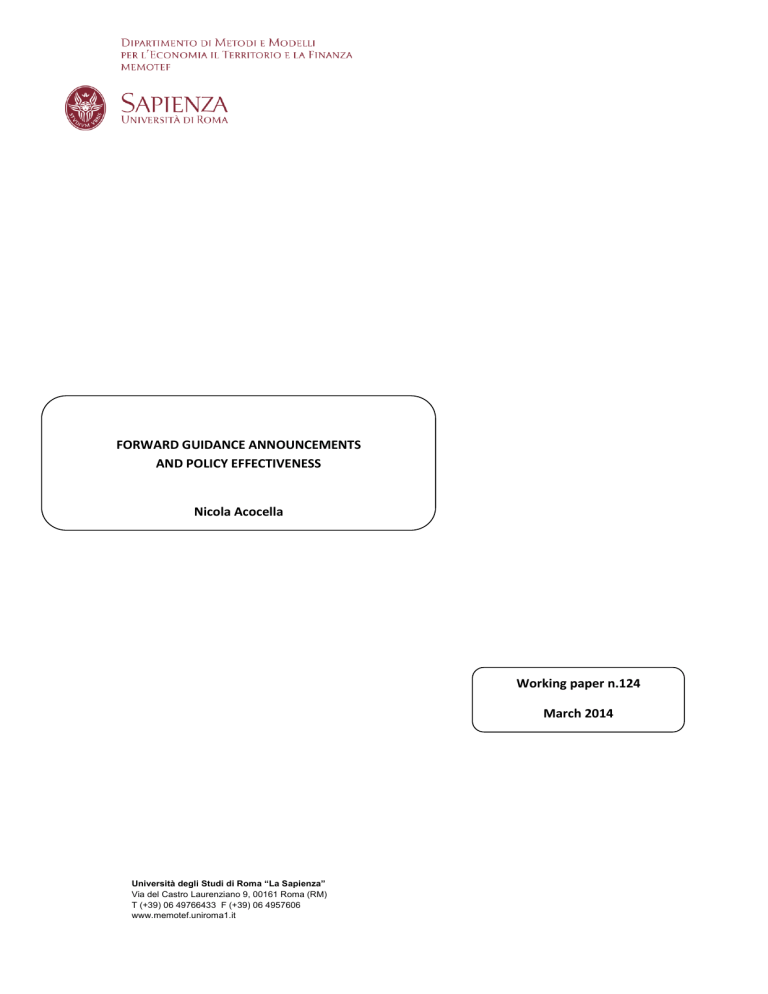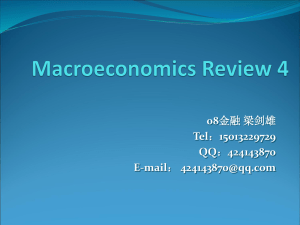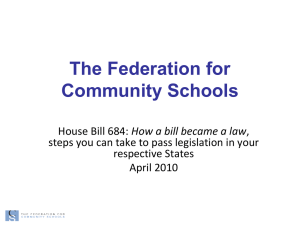here - Sapienza

FORWARD GUIDANCE ANNOUNCEMENTS
AND POLICY EFFECTIVENESS
Nicola Acocella
Working paper n.124
March 2014
Università degli Studi di Roma “La Sapienza”
Via del Castro Laurenziano 9, 00161 Roma (RM)
T (+39) 06 49766433 F (+39) 06 4957606 www.memotef.uniroma1.it
FORWARD GUIDANCE ANNOUNCEMENTS
AND POLICY EFFECTIVENESS
1
Nicola Acocella
2
ABSTRACT
In this paper we investigate the foundations of forward guidance in the light of the theory of controllability in a strategic context. The announcement of future suitable policies can facilitate the control of the economic system by the policymaker, where the term ‘control’ is used in the sense of the ‘classical’ theory of economic policy developed by Tinbergen (1952) and others and recently revived in a strategic context. In this context the contribution of forward guidance to controllability has been recognized. However, existing studies have not indicated either the ways through which the different types of announcement can have this effect or the necessary conditions for that.
Classification JEL: D84, E52, E61
Keywords: Forward guidance, Controllability, Theory of economic policy in a strategic context.
1.
I NTRODUCTION
In this paper we investigate the foundations of forward guidance in the light of the theory of controllability in a strategic context. The announcement of future suitable policies can facilitate the control of the economic system by the policymaker, where the term ‘control’ is used in the sense of the ‘classical’ theory of economic policy developed by Tinbergen (1952)
2
and others and recently revived in a strategic context, by, e.g., Acocella, Di Bartolomeo, Hughes Hallett (2012). This has been shown by Acocella, Di Bartolomeo, Hughes Hallett (2012), which, however, does not specify the contribution of the different types of forward guidance to controllability. We aim at indicating the ways through which an announcement can have this effect and the necessary conditions for that.
In the next section we illustrate the different notions of controllability. In section 3 we list the various types of forward guidance (fg). Section 4 illustrates the information available to the agents in a model with exogenous rational expectations and to players in a strategic game. Section 5 tends to qualify how the specific information provided by the different types of forward guidance can facilitate controllability, by adding to the information already available to the
1
The paper benefitted from discussions with Giovanni Di Bartolomeo. Some parts of the various
2 sections draw on Acocella, Di Bartolomeo, Hughes Hallett (2012), Part IV.
Sapienza University of Rome, nicola.acocella@uniroma1.it.
2
A complete presentation of the theory, also in its dynamic form we are interested in, can be found in Preston, Pagan (1982) and Hughes Hallett, Rees (1983).
2
private sector having rational expectation or in a Stackelberg game. Section 6 concludes.
2.
T HE NOTIONS OF CONTROLLABILITY
We refer to a dynamic policy problem where the private sector has rational expectations. We state the problem in rather general terms. For some uses we will change some of the assumptions of the problem as indicated here, mainly with reference to uncertainty.
The economy is described by the following difference equation, which includes the policy rule followed by the policymaker
3
, as will be clear from the example below:
(1) y t
Ay t
1
Bu t
Cy t
1| t
v t for t = 1… T , given values for y
0
and y
T
, where y
R
S
is the vector of the states of the system, which are the p olicymaker’s target variables, y t
1| t
t
1
|
t
denotes the mathematical expectation of y t
1
conditional on
(the common information set available to all t the agents at t ) and u t
is the vector of control variables in the hands of the policymaker. Matrices A , B and C are constant and of order S ,
, and S , respectively, and have at least some nonzero elements. In this representation, y
0 is a known initial condition, and y
T +1
is some known, assumed or expected, terminal condition which is part of the information set
t
. Finally v t
is a vector of exogenous shocks or other influences on y , which has a known mean but comes t from an unspecified probability distribution.
3
As is clear from the literature, such rule may differ from those deriving from optimization of the preference function of the monetary authority under the constraint of the model of the economy. This is also true for the Taylor rule, which can however be interpreted as a simple way of capturing the rule derived from minimization of the central bank’s loss function
(according to Woodford, 2001: 19, ‘the Taylor rule incorporates several features of an optimal monetary policy, from the standpoint of at least one simple class of optimizing models’). Taylor rules are also used to cross-check optimal policy rule, because of their robustness to imperfect knowledge of the model of the economy (e.g., Tillmann 2011; Bursian, Roth. 2013).
Alternatively, instead of the policy rule we could add to the model the first-order condition of the central bank’s loss function derived by minimizing this under the constraint of the model of the remaining part of the economy. In our case, by assuming that the central bank is interested in all the variables of the reduced form system, we could minimize
(2) L
E t
T
1
y t
y t
t
y t
where
, y
R
S is its vector of desired target values, and Q is a full rank matrix of assigned weights.
3
The final form model can be written as:
(3)
y
1|1
.
.
.
y
T |1
R
11
R
.
.
.
T 1
.
.
.
.
.
.
.
.
R
.
.
R
.
.
1 T
TT
u
1|1
.
.
b
1|1
.
.
.
.
u
T |1
b
T |1
, or y
Ru
b where R
T
T
1
( I
B ), b
T
T
1
( |
1
)
A
: 0
y
0
0 :
T
1|1
,
denotes the Kronecker product and T
T is the Toeplitz matrix in (4), i.e.:
(4) T
T
.
I
C
0
0
A
.
I
.
.
0
0
.
.
.
A
0
0
I
.
C
.
There are different notions of controllability in a dynamic setting:
1) Static controllability: policy instruments have the ability to reach any specified set of target values, from an arbitrary initial position, in expectation , within a single decision period.
2) Multi-period static controllability: policy instruments have the capability to reach any specified sequence of desired target values (from an arbitrary initial position), in expectation, at every point within an interval containing an arbitrary number of consecutive decision periods.
3) Dynamic controllability: policy instruments have the ability to achieve an arbitrary set of target values, in expectation, at a single point a certain number of periods in the future, given an arbitrary starting point and without concern for what values those targets or other variables might take along the way or after the target values have been achieved.
4) Path controllability: policy instruments have the ability to achieve an arbitrary set of target values a given number of decision periods after an arbitrary start; and then either hold those values or follow some pre-specified path of target values, again in expectation, at each decision point for an arbitrary period of time thereafter.
Given S and m , these concepts of controllability define the capacity to reach the desired targets over an interval of length T , i.e. [ t
0
, t
0
+ T ], starting the policy actions in period t
0
– P :
4
1.
2.
3.
4.
Static controllability:
Path controllability:
Multi-period static controllability:
Dynamic controllability:
P = 0 T = 0.
P = 0 T > 0.
P > 0 T = 0.
P > 0 T > 0.
4
We are specifically interested in static and dynamic controllability. In more formal terms, an economy (model) is said to be dynamically controllable if a sequence of instrument values u
1
,............, u t
can be found that will reach any arbitrary values, y t
, for the target variables in period t (at least in expectation) given an arbitrary starting point y In this case, differently from the case of static
0
.
controllability, we are not concerned with the period-by-period controllability of the target variables between periods 1 and t –1. Starting from period 1, dynamic controllability therefore requires a sequence of intended instrument values, u
1|1
,....., u say, that guarantee
T |1 y t |1 is reached in period t=T . This is possible only if the sequence of policy multipliers and anticipatory effects in the t -th row block of
(3), i.e. [ R t ,1
.....
R ], is of full rank ( r[ R R t ,1
....
]
S ), given an arbitrary initial state y
0 and a specified terminal condition y
T
1|1
(Acocella, Di Bartolomeo, Hughes Hallett,
2012).
3.
TYPES OF FORWARD GUIDANCE
Fg has been introduced as an innovative way of dealing with a situation of limited effectiveness of monetary policy action, especially in proximity of the zero-bound level of interest rates (Woodford, 2013). There are 3 types of fg: ‘open-ended’;
‘time-contingent’ or ‘calendar-date’ or ‘date-based’; ‘conditional’ or ‘threshold’
(CESifo, 2013; Plosser, 2013). They have been introduced by monetary authorities, but could also be used by other policymakers..
The first type of fgis a very loose one, as it indicates that the current stance will continue for an indefinite time period. This form of fg was implemented by the
Federal Reserve in August 2003 and again in December 2008 and by the ECB in
July 2013. The second type of fg was introduced by the Bank of Canada and the
Swedish Riksbank in April 2009, by the Federal Reserve in August 2011. It announces that the central bank will implement a given (in our case, an accommodative) action for a certain period of time, possibly with a proviso referred to the evolution of some relevant variables (e.g., inflation keeping at moderate values) (Board of Governors of the Federal Reserve System, 2011)
5
.
4
More on the meaning, conditions for, and implications of, the various concepts of controllability in a dynamic setting can be found in Acocella, Di Bartolomeo, Hughes Hallett (2012).
5
Krugman (1999) and Eggerston, Woodford (2003) had suggested to credibly promise a given expansionary stance for even longer than required by the economic situation. This suggestion was followed by the Fed during the 2003-05 crisis, but was then blamed it for nourishing the housing bubble, even if adherence to the promise was due to the desire to maintain credibility
(Gurkaynak, 2012). The initial suggestion has been replicated by Woodford (2013). We will be more specific on the exact content of history-dependent rules below.
5
Conditional fg – to which the Federal Reserve shifted in December 2012 and that has been adopted by the Bank of England too in August 2013 - indicates the conditions of the economy (in terms of the values of some relevant policy targets) to which a certain policy is tied. The policymaker can announce its policy target values – the Fed indicated an unemployment rate of 6.5% and an inflation rate of
2.5% –but no policymaker has hitherto announced a precise policy rule, i.e. not only target values, but also marginal rates of substitution between targets or even a ‘history-dependent’ rule of the kind advocated by Eggertsson, Woodford (2003).
Such rules can be thought to be a kind of commitment more than an announcement.
Fg acts on expectations in substance. Low nominal interest rates expected for some period can stimulate investment and possibly consumption. If the current nominal interest rate is near zero, an expected higher inflation rate – e.g. as a consequence of an announcement (or commitment) of the kind suggested by a history-dependent rule – can not only help keeping expectations of the real rate low but also push expected real interest rates to the negative.
Given the vagueness of the period of ‘validity’ of the promise, the first type of fg is not considered to be particularly effective. In fact, markets did not show specific reactions to similar announcements. However, this does not rule out the possibility that they had some degree of effectiveness, as we do not know the possible alternative conduct of the market. The most effective types of fg are the ‘ timecontingent ’ and ‘ conditional’ ones.
A first shortcoming of the former is that it might be interpreted either as a credible promise or as the expected policy if the policymaker has made correct predictions on the duration of the sluggish change in the level of real variables and low inflation. This ambiguity derives from the fact that time-contingent fg does not explicitly indicate the value of targets a given course of policy action is tied to. To be a credible promise this action should be prosecuted also in the case when either exogenous shocks or the endogenous evolution of the system or both improve the situation in an unpredicted way
6
. But this could imply a suboptimal solution and thus be time inconsistent. Because of this, according to some economists, time-contingent fg has more of the nature of a Delphic prophecy and is perceived as such by the market (Meyer, 2012). It can however still reduce private sector’s uncertainty (Campbell et al 2012: 2). One reason of effectiveness has to do with the fact that the fear of time inconsistency can be counterbalanced by the possibility that markets interpret the promise to keep interest rates low even beyond the time when monetary authorities’ target values have been reached as an intentional and credible move to create expectations of a relatively high
6
In principle, also the opposite case shou ld be considered, i.e. the economy’s situation can deteriorate in such a way as to ask for a stronger accommodative action. However, when the policy stance has already hit the zero-level-boundary, only enactment of other policy actions could deal with the new situation.
6
inflation and very low or negative real rates (Eggertsson, Woodford, 2003)
7
This would impart a more powerful incentive to aggregate demand.
Conditional forward guidance has the advantage of being more flexible while indicating values of targets that, at least when the current and the prospective evolution of the economy is far from satisfying them, resembles more an
Odyssean commitment, thus potentially changing public expectations (Campbell et al 2012, 3)
8
. In fact, it specifies at least some parameters of the policy rule followed by the central bank , i.e. of the relationship between the central bank’s instrument and its targets. Fed ’s announcement of 2012 concentrated on a couple of points (Plosser, 2013), which may be thought as a sufficient condition for successful guidance under the conditions indicated above. If, instead of an announcement about the rule, a time-contingent or conditional one is made, the private sector could ‘learn’ about the expected policy rule by taking into account and comparing a number of indicators, such as the projections of some relevant variables (e.g., interest rates, inflation rates) by the policymaker, its actual behavior and the evolution of economy.
Consider that conditional fg can be amended in a way that leads to an even more effective and credible promise, if some target, e.g. the inflation target, for the next periods is made history-dependent, by taking account of both the current evolution of the relevant targets and their target levels, as suggested by
Eggertsson, Woodford (2003) and Woodford (2013). In the case of monetary policy, a history-dependent announcement (or commitment) consists in some rule specify ing a policy that should result in higher inflation expectations when the interest rate is bounded to a zero level boundary.
In the next two sections we try to disentangle the different kind of information available to the private sector with fg from that can be reasonably assumed to be available to players in a strategic game. We specifically refer to conditional fg, but can also refer to the information provided by open-ended fg and time-contingent fg, which serve also as a term of comparison.
An issue that must be tackled refers to the difference between fg and commitment
9
. The former is a kind of announcement (cheap talk) and differs from the latter as it simply conveys information about future policy decisions, the inflation target value, etc. The policymaker communicates information concerning its future conduct that, differently from commitment (a binding message), does not tie its hands to a unique course of action, but leaves it some freedom under certain contingencies. That said, one must consider that there is a continuum between discretion and commitment, as first clarified by Chari, Kehoe, Prescott
(1989) and reminded by Ridley (2012). In addition, perfect commitment can only be possible for a Ramsey policymaker with complete authority, infinite life, perfect
7
However, this does not mean that Eggertsson, Woodford suggest adoption of a purely datebased type of fg, as Woodford (2013) confirms. Their proposal is of a history-dependent rule,
9 as we will shortly see.
8
Similar kinds of fg were suggested by Evans (2011, 2012) and Romer (2011).
Confusion on this distinction has occurred among many central bankers and economists
(Blinder, 2009: 4).
7
communication and complete credibility (Levin, 2012). To be effective, however, fg must have a high degree of credibility, which means that the policymaker has no incentive to deviate from the announced action, unless under exceptional circumstances. This gives an incentive to the private sector to behave in the desired way. Then both parts tend to prefer this course of action to others. Perfect commitment to some action would guarantee that this action will be chosen in any case, i.e. whatever external shock may hit the economy and even if this is suboptimal for the policymaker. If the economic situation and the foreseeable future are such that these circumstance and reasons for not complying to it appear to be as exceptional, fg can be effective even if it does not imply a (perfect) commitment. To this end it might not cover all the determinants of its conduct, but only a part of them. Considering all these features of a (perfect) commitment, it is really difficult to find a similar case of engagement taken by a policymaker in practice. Then we leave it open the issue of the true nature of a history-dependent rule.
4.
I NFORMATION AVAILABLE WITH RATIONAL EXPECTATIONS AND IN STRATEGIC GAMES
To begin, let us discuss in this section the kind of information that is supposed to be available to agents with rational expectations or to players in a strategic game.
The case where there is a single policymaker and the private sector is assumed to have rational expectations is equivalent to a Stackelberg game with the private sector as the leader and the policymaker as the follower. Each player is assumed to know either the model of the economy and the strategy chosen by his opponent, in the case of a Stackelberg follower, or the model of the economy and his opponent’s reaction function, in the case of a Stackelberg leader or of players playing Nash. To be sure, the reaction function is apparently different from the rule adopted by the central bank to respond to the values taken by the variables relevant to it as a consequence of the evolution of the economy, i.e. from the rule it follows in setting its instruments in response to gaps between the current values of the target variables and its target values. However, this rule is equivalent to the leader’s quasi-reaction function, i.e. a quasi-best response function in terms of targets, rather than instruments,
10
as the latter can be derived from the former, up to a constant.
For simplicity let us refer to the case when the private sector has rational expectation. In this case the private sector knows the economy’s model (1), including the policy rules, exploits all the information available at time t
0
and correctly forecasts the expected value of the relevant variables of the model. If the problem is dealt with in terms of a Stackelberg game, it is assumed that the private secto r knows the economy’s model and the reaction function of the central bank. As said, the latter is equivalent to a quasi-reaction function obtained – in a way similar, but not identical to the reaction function – by minimizing the central
10
For a formal definition of these see Acocella, Di Bartolomeo, Hughes Hallett (2012: 104).
8
bank ’s loss function under the constraint of the model. The private sector knows both its target values and the marginal rates of substitution among them. In addition, both the private sector and the policymaker know the model of the economy. Let us assume that they share the same model of the economy . Both agents then share the same information set.
Under the assumptions of perfect certainty , symmetric information about the model of the economy (including the current and future policymaker’s payoff) as well as rational expectations
11
, fg can add no information to that available to the private agent. With these (absolutely unrealistic, but useful as a term of comparison) assumptions, the model presented above, in which v = 0, holds. In t this case, even if the policymaker has more than one target but only one instrument, it should have full static controllability of the economy in a dynamic setting. In fact, when T ≥ S and t < T , but the horizon is long enough to fulfil the rank condition r[ R t ,1
....
R ]
S , dynamic controllability should be ensured even without forward looking expectations. Rational expectations accelerate the possibility for the policymaker to control the economy from any date, as the private sector anticipates the future behavior of the policymaker and knows that the latter can control the economy.
Let us now depart from the assumption of perfect certainty, retaining the other assumptions. We initially assume that there may be additive shocks to the economy, i.e. v ≠ 0, again, as in (1). This makes the expected future reaction of t the policymaker uncertain. Were its preference function known with certainty, it would be possible to derive its reaction function and decisions. Its future policies would be uncertain, simply because shocks to the economy may occur, but the assumption of rational expectation would ensure knowledge of the expected reaction to them. Again, no announcement could be informative in these conditions. In order for an announcement to add information to that already available to the private sector, one must add uncertainty (or absolute ignorance) of the policymaker’s future preferences. Announcements can make public action
(more) effective either as they can add information on future expected decisions or as they inform about (parts of) the loss function itself. While open-ended and time-contingent fg are announcements adding information about actions, conditional fg communicates information referred directly to the preference function.
11
If this can have any role at all in a model with certainty. Rational expectations could be intended in their ‘weak’ forma, as model-consistent expectations (see Snowdon, Vane,
Wynarczyk, 1994), an assumption that is equivalent to that of knowledge of the model by both agents.
9
5.
I
NFORMATION ADDED BY FORWARD GUIDANCE WITH RE AND ITS ROLE IN FACILITATING SYSTEM
’
S
CONTROLLABILITY
5.1. Introduction
In order to see now whether, when and how fg can add to the information already available to the private sector having rational expectations, as indicated in section
4, we must move outside the model of perfect certainty or of additive uncertainty as to the model. We will retain or not the other assumptions introduced there.
We show that the nature of information and the degree of confidence in it is different for the different types of fg, due to the different nature of uncertainty
‘covered’ by different announcements. As a consequence, the impact on controllability differs. In reality, uncertainty is widespread as it can first refer to the model’s correspondence to reality, in relation to the possible occurrence of shocks
(and for this it is common to both the private sector and the policymaker). In addition, it can involve the policymaker’s preference function (and in this case it is, at least as a first approximation, asymmetric
12
) and, as a consequence, the policy rule it follows or the expected value of the instruments at future dates. We will see that some types of fg are promises, with different degrees of credibility and a different ‘coverage’ of uncertainty.
5.2 The additional information provided by open-ended forward guidance
We will assume, until different statements are made, that the model is (additively) uncertain, the preferences of the policymakers are unknown. Without loss of generality, we further assume that m = 1 < S for our policymaker and that T ≥ S .
In general, fg implies an addition of promised expected values to the set of instruments to be chosen by the policymaker’s for t > 1. In fact, as said in section
2, by open-ended fg the policymaker announces that the current stance will last for an indefinite period of time. There is no certain promise for the future policies, t
> 1 onwards. This implies that elements of ( u
2|1
,..., u )’ in (3) have different and
T |1 possibly highly subjective degrees of likelihood. The fact that continuation of the current policy is uncertain – and decreasingly probable with the elapsing of time – makes it clear why this kind of fg can have a beneficial role, but is not very effective.
That said, different types of uncertainty (or ignorance) about the policymaker’s preferences may reduce or widen the benefits accruing from the announcement.
Ignorance of the nature and of the precise number of targets and target values pursued by the policymaker and the marginal rates of substitution between the
12
In a dynamic setting ignorance or uncertainty about the policymaker’s future preferences can also affect the policymaker itself, e.g., for reasons related to the future composition of the ruling committees. This would be a very difficult case to deal with in analytical terms and we will largely rule it out of our study.
10
targets would add to ineffectiveness. By contrast, if the private sector knew even simply the number of targets (as a result of general information about the policy maker’s ‘mission’ or as an effect of other announcements), we could say that ineffectiveness would be lower, the lower the number of targets S pursued by the policymaker and the higher the number of policy instruments. A high targets/instruments ratio could add to credibility of the promise. To some extent the credibility of the announcement would also depend on the reputation of the policymaker and the distance between the current and the expected future states of the economy.
This kind of fg can give no assurance about not only shocks, but also changes in the policy targets.
5.3. The additional information provided by time-contingent forward guidance
As said in section 2, time contingent fg avoids uncertainty as to the timing of exit policies. If the private sector knows the number of targets (as we assumed in the previous sub-section), maintenance of the current policy is guaranteed with certainty (or reasonable certainty) for a certain length of time, which enhances policy effectiveness. In this case we can say that clarification of the horizon of current policy can help to bridge the gap between the number of instruments and that of targets. Obviously, the possibility to control the system depends on both the duration of the policy (let us call it t* , including the current period) and the time horizon of the private sector. If the latter is much longer than the former, the effectiveness of the policy is scarce and the dynamic controllability of the system is hardly ensured. Effectiveness is also lower the higher the number of targets S pursued by the policymaker and the lower the number of policy instruments.
Let us assume that time-contingent fg offers information for 2 periods, in addition to the current one, which implies that t *= 3. If the policymaker has a reputation for sticking to its announcements, information about the policy stance at time t = 3 is as reliable as that for time t = 2, etc. More generally, if t *= T , elements of ( u
2|1
,..., u )’ in (3) are all known with reasonable certainty, which makes the
T |1 system statically controllable from t =1, even if the policymaker has only one instrument and the number of its targets is S = T .
A problem might derive from the fact that, due to possible shocks, this type of fg may result suboptimal after the period when targets are hit. This could give an incentive to the policymaker not to implement the announced policy, after reaching its target, thus creating an issue of time inconsistency and reducing its credibility.
If expected shocks (as for, e.g., expected growth abroad) are low, at least for some periods, the risk of sub-optimality of the announced policies is low or practically nil. But even in the case when this risk is apparently significantly different from zero, the announced policy can indeed be optimal for two reasons.
One has to do with the fact that the private sector can trust the announced policy: even if this were suboptimal, private agents can in fact intend the possible
11
cost to the policymaker of sticking to the announced policy as a the typical cost necessary for commitment, thus making the announcement credible.
But there is another reason why the announced policy can be optimal even if the horizon to which the announcement refers is beyond the date at which the policymaker expects its targets to be reached. This has to do with the reasoning underlying the suggestion of a history-dependent kind of fg by Eggertsson,
Woodford (2003). As seen before, this kind of fg is different from a time-contingent
( ‘fixed-date’ in their terms) announcement. In fact, in this sub-section we consider a promise of future policies, independently of both future conditions and the distance between current and future conditions from the target value. In this type of fg target values are even not mentioned by the policymaker, which only announces future policies. However, even if the type of fg we are dealing with is different from that suggested by Eggertsson, Woodford, a reasoning similar to that involved in the optimality of the latter (specifically, by keeping expectations of inflation high even beyond its target value) may positively influence the private sector and add to the effectiveness of time-contingent fg. This type of fg does not indicate any target value, but the very prospect of the possibility for the policy to be continued even after this unknown target value is reached can increase expectations of an increasing inflation rate and thus of a negative real interest rate.
This type of fg does not cover uncertainty about changes of either policy targets or parameters (or both) of the policymaker’s loss function.
5.4. The additional information provided by conditional forward guidance
In the previous two sub-sections we have assumed that the model is uncertain
(because of additive shocks), while the policymaker’s payoff is unknown. The indication of at least some parameters of the rule that will be followed by the central bank (more generally, by the policymaker) – instead of future decisions – adds knowledge useful for making it easier to control the economy. Let us refer more specifically to the exact Fed’s announcement of this kind of fg. In July 2013
President Bernanke, in confirming the December 2012 decision of the FMOC, made it clear before the Congress that, first, no exit policy would be adopted ‘at least as long as the unemployment rate remains above 6.5 per cent and inflation and inflation expectations remain well behaved in the sense described in the
FOM C's statement’ (implying that long-term inflation is below 2 per cent). In addition, ‘the specific numbers for unemployment and inflation in the guidance are thresholds, not triggers. Reaching one of the thresholds would not automatically result in an incr ease in the Federal funds rate target’ (Bernanke, 2013).
In this case the Fed President not only indicated, in the first part of his statement, the target values of the central bank’s loss function (and, obviously, the type of targets pursued), but also made a partial step towards the kind of fg (or commitment) suggested by Krugman (1998) and Eggertsson, Woodford (2003).
Let us refer briefly to the first part. Comparison of the target values of the Fed with
12
reality (remember that the unemployment rate in the US had been stagnating around 8% for the whole year 2012, with only a negligible reduction, thus well above the Fed’s target value) could boost investment. As to the second part, the monthly inflation rate average since May 2012 had been 1.7-1.8%, comfortably below 2%, but with highs of 2.0-2.2% in a couple of months. The Fed was thus delivering a clear message that the current stance would be likely to continue also after reaching one of the target values. In particular, hitting the inflation target value would not necessarily imply a halt to the expansionary policy, as (and until when) the other target had not been hit. The whole announcement can be understood as a step towards Eggertsson and Woodford’s proposal. For our purposes
13
we can interpret this as due to the fact that, even if Bernanke’s announcement referred to target values only, and did not include the marginal rates of substitution of Fed’s loss function, there was a clear indication that substitutability between the two targets might make the central bank not to initiate a policy contraction even if inflation is above its target value. All in all, instead of announcing continuation of the current policy for a given period – as in the timecontingent case – the policymaker practically promises to continue the current policy for the whole period necessary to hit both targets, or at least to have a satisfactory mix of them. This kind of announcement is likely to be informative for the private sector.
The central bank could give a different and more complete form of conditional fg announcement, by indicating the Taylor rule it follows. In this case it would also announce the rates of substitution among its targets. If we stick to the usual rational expectation assumption, this information should be enough to deduct the same implications as Eggertsson, Woodford ’s (2003). Communicating the Taylor rule would in practice be a kind of (soft) commitment, the possibility still being open of a change in the parameters of the Taylor rule (as well in the very nature of targets) favoured by monetary authorities, following the insurgence of new unexpected needs or, in any case, a change in the orientation of the persons in charge with the monetary policy. This would introduce the assumption of another kind of uncertainty, as uncertainty about the marginal rates of substitution is multiplicative, not additive.
In the two types of fg we have dealt with in the two previous subsections, uncertainty or ignorance remained about the policymaker’ preferences, as the promise referred to the actions, leaving their determinants relatively uncertain or obscure. Given that this uncertainty is not removed, at least partially, by the policy announcement, the only way to indirectly indicate future preferences is a promise of future policies. Instead, conditional fg (partially) removes uncertainty as to the preference function, thus trying to offer indications about the source of future policies to the private sector. The prospect is still uncertain in so far as uncertainty about the model survives, some specific parameters of the policymaker’s
13 We are reasoning not in terms of commitment, as Eggertsson, Woodford’s (2003) proposal can be interpreted to do, but of announcements as purely adding information to the system.
Obviously, however, this involves some credibility argument. We have, in fact, already said that the difference between fg and commitment may become very thin.
13
preference function may be unknown or, in any case, are open to possible future changes. However, the degree of confidence of the private sector should increase with this type of fg. Open-ended and time-contingent fg could improve policy effectiveness in so far as they give some kind of assurance about invariance of policy with respect to shocks affecting the economy. Uncertainty about the policymaker’s loss function is the focus of conditional fg. At least to some extent, eliminating or reducing this source of uncertainty can be thought of as giving a larger ‘coverage’ to the effects of the announcement and a more credible way of announcing future policies, at least in so far as possible external shocks are thought to be unlikely to bridge gaps between announced and current values of policy targets.
According to some economists, this type of fg could be intended as a true commitment policy. However, this is not the case for a number of reasons. First, because, at least in the version hitherto implemented, this type of fg does not cover the policymaker’s marginal rates of substitution among its targets. This could negatively affect its effectiveness when the economy is close to target values or has hit some of them. Moreover, as Blinder (2012) noticed, there might be more than a single, invariant Taylor rule, since new targets may emerge in addition to the standard ones (Romer, 2012). Finally, policy orientations might change through time, which would have very different implications in terms of interest rates. This has certainly been the case for the Fed in the past.
In more formal terms, conditional fg announcements would add, e.g., for the private sector, information of the following kind to that already available as a consequence of the assumption of knowledge of the model:
(6) ( , t
_ u t
g y y t
) , where we have indicated also target values, as relevant information.
The details of this relation may however be different. In any case the private sector can be informed about the policymaker’s target values and, possibly, also its marginal rates of substitution among the targets.
Were the policymaker a central bank, complete conditional fg announcements would take the form of announcing the Taylor rule it complies to, and equation (6) could take a form like the following one:
(7) i t
t
a
(
t
t
)
a y y
( t
_ y t
) where i t
is the bank’s policy tool (usually the short-term nominal interest rate; e.g. the Federal funds rate in the US),
t
is the rate of inflation,
* is the desired rate of inflation, r t
* is the assumed equilibrium real interest rate, y t
is the logarithm of
_ real GDP, and y is the logarithm of potential output.
14
This would offer information about the bank’s targets, its target values and the marginal rate of substitution between inflation and income (or unemployment). In the case of the Federal Reserve in December 2012, only
* and
_ y
were announced, not the rate of substitution between output (or unemployment) and inflation.
5.5. Some considerations common to the different types of fg
First, we summarize the results of our analysis so far, by stating the pros and cons of the various cases of fg for system controllability in the following table:
We must now clarify some methodological aspects of our investigation. We have seen that fg can have no effect under the strict assumptions of the basic model listed at the beginning of section 5.1. This implies that, in order to explain its effectiveness, some additional degree of realism must be added to the model, by removing some of those assumptions. This is certainly so for perfect certainty, which we have replaced with additive uncertainty in the model and ignorance about the loss function, whose knowledge is substituted by announcements of the future values of policy instruments or of parts of the loss function. In the case of conditional fg, partial knowledge of the loss function is introduced but marginal rates of substitution are left unknown (in the experience so far), which implies a kind of multiplicative uncertainty. The form of conditional fg used by the Fed in
2012, in fact removed only uncertainty about target values in the policymaker’s loss function. Announcing the policy rule would add information as to the marginal rates of substitution, leaving only uncertainty as to future changes of the loss function.
15
Table 1: The pros and cons of forward guidance for system controllability
Cases of fg Pros Cons
Any type of fg in the basic model
None None with certainty (see sect. 5.1. for other assumptions)
Open-ended fg
Time-contingent fg
1. Higher effect in the short run, with high reputation, high m , low S , low expected changes of the economy
1. Higher effect for high t *, high reputation and high m , low S , low time horizon of the private sector, low expected changes of the
1. low effect in the long run, with low reputation, etc.
2. private sector ignores targets, target values and mrs
1. Possibility that the announced policy is suboptimal at some future t economy
2. high credibility if announcement interpreted as is a commitment
3. lasting policy as a way to stimulate expansion at the ZLB
1.Covers (partial or total) ignorance of the loss function
Conditional fg 1.Partial assurance in case of shocks to the economy
2. No info (until now) about the mrs
3. No coverage for changes in the arguments and parameters of L or the policy rule
This repetition is in order to stress that, together with certainty of the model and/or the pol icymaker’s preference function, another assumption has been removed throughout subsections 5.2 to 5.4 in order to assess the effectiveness of fg. In fact, symmetric information about the policymaker’s payoff no longer survives there, unless the whole policy rule is made known to the private sector, which is what happens under the most informative kind of conditional fg. Other assumptions, i.e. that of rational expectations (at least in so far as the solution of the model once the policy rule is known) and symmetric knowledge of the model of the economy, are retained. Removing one of these assumptions would require
16
adding some kind of learning in order to assess the possible benefits of fg. One could start by assuming that policymaker’s knowledge is certain while the private sector’s is not and try to see how fg can help the private sector to learn it.
Learning would also be useful, at least to some extent, in the case where all or some of the parameters of the policy rule are unknown.
6.
C ONCLUSIONS
We have shown that forward guidance adds information to the private sector that can enhance effectiveness of policy, in way and to an extent that depends on the type of information provided by each specific type of announcement. In fact, this can ensure dynamic or even static controllability in a dynamic context.
REFERENCES
Acocella N., G. Di Bartolomeo, A. Hughes Hallett (2012), The theory of economic policy in a strategic context, Cambridge University Press, Cambridge
Bernanke B. S. (2013), Semiannual monetary policy report to the Congress before the
Committee on Financial Services, U.S. House of Representatives, Washington, D.C., July
17.
Board of Governors of the Federal Reserve System (2011), Minutes of the FOMC, August
9
Bursian D., M. Roth (2013), Optimal policy and Taylor rule cross-checking under parameter uncertainty October 10, mimeo
Blinder A. (2012), Comments and discussions on Campbell, Evans, Fisher, Justiniano
(2012), p. 75
Calomiris C. W. (2012), Comments and discussions on Campbell, Evans, Fisher,
Justiniano (2012), p. 56
Campbell J. R., C. L. Evans, J. D. M. Fisher, A. Justiniano (2012), Macroeconomic effects of Federal Reserve forward guidance, Brooking Papers on Economic Activity, 1, 1-54.
Chari V. V., P. J. Kehoe, E. C. Prescott (1989), Time consistency and policy, in R. Barro
(ed.), Modern business cycle theory, Harvard University Press, Cambridge, Mass., 265-
305
CESifo (2013), World Economic Survey, 12(4): 19
Eggertsson G. B., M. Woodford (2003), The Zero Bound on Interest Rates and Optimal
Monetary Policy, Brooking Papers on Economic Activity, 1: 139
–211
Evans C. (2011 ), The Fed’s dual mandate responsibilities and challenges facing U.S. monetary policy, Remarks delivered at the European Economics and Financial Centre
Distinguished Speaker Seminar, London, September 7.
Evans C. (2012), Monetary policy in a lowinflation environment: Developing a statecontingent price-level target, Journal of Money, Credit and Banking, 44 (s1)
17
Gagnon, J., M. Raskin, J. Remache and B. Sack (2010), Large scale asset purchases by the Federal Reserve: Did they work? Federal Reserve Bank of New York, Staff report 441,
March
Gurkaynak R. (2012), Comments and discussions on Campbell, Evans, Fisher, Justiniano
(2012), p. 76
Hughes Hallett A., H. Rees (1983)
Kiley M. (2012), Comments and discussions on Campbell, Evans, Fisher, Justiniano
(2012), p. 77
Krugman P. R. (1999), It’s Baaack: Japan’s Slump and the Return of the Liquidity Trap,
Brookings Papers on Economic Activity, 2: 137
–87
Meyer L. (2012), Comments and discussions on Campbell, Evans, Fisher, Justiniano
(2012), p. 77
Levin A. (2012), Comments and discussions on Campbell, Evans, Fisher, Justiniano
(2012), p. 79
Plosser C. I. (2013), Forward guidance, Federal Reserve Bank of Philadelfia, 12 February, mimeo
Preston, Pagan (1982)
Romer C. D. (2011)
, Dear Ben: It’s Time for Your Volcker Moment, The New York Times,
October 29, 2
Romer D. (2012), Comments and discussions on Campbell, Evans, Fisher, Justiniano
(2012), p. 74
Snowdon, B., Vane, H., Wynarczyk, P. (1994). A modern guide to macroeconomics. (pp.
236
–79), Edward Elgar, Cambridge
Tillmann P. (2011), Cross-checking optimal monetary policy with information from the
Taylor rule, MAGKS Joint D.P. in economics, Universität Marburg n. 32
Tinbergen J. (1952), On the theory of economic policy, North-Holland, Amsterdam
Woodford M. (2001), The Taylor Rule and Optimal Monetary Policy, mimeo, January
(shorter version published in American Economic Review, 2001, 91(2): 232-237)
Woodford M. (2013),
Forward Guidance by Inflation-Targeting Central Banks, Penning-
Och Valutapolitik, Sveriges Riksbank, 3 (Jubileumsnummer): 81-120
18










